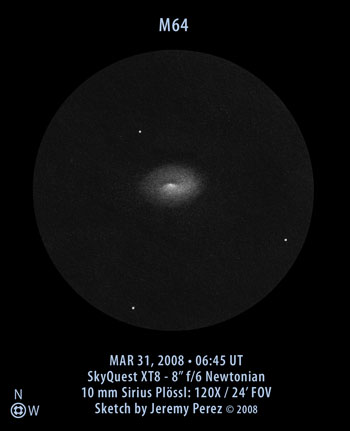
Click image for larger version.
Observation Notes:
Home is not the best place to soak in galactic light, but I’ve got to take what I can get! After scooping up a variety of galaxies with my 15 x 70 binoculars, I decided to take a closer look at M64 with the 8-inch Dob. The galaxy was elongated from east to west, with a core that was bright and appeared stellar. It dropped sharply in brightness on the north side of the core, suggesting a dust band. The galaxy appeared brightest across the southwest quadrant. The northern outer perimeter also had a sharper boundary.
Object Information:
This fascinating galaxy is well know for it’s prominent dust lane that has earned it the name “Blackeye Galaxy”. The galaxy has two counter-rotating discs of gas, dust and stars. It may be the reason vigorous star formation is observed and noticeable in the dust lane. It is also thought that this condition was caused by a former companion galaxy that has merged with, but not yet settled into the orbital plane. It’s distance is not well determined, and has been estimated from 16 to 44 million light years. A recent press release from the Space Telescope Science Institute gives a value of 19 million light years. At this distance, the galaxy’s diameter would be 51,000 light years. M64 was discovered by Edward Pigott in 1779. It is also catalogued as NGC 4826, UGC 8062, MCG+04-31-001, h 1486, GC 3321,CGCG 130.001, KARA 559, IRAS 12542+2157, PGC 44182.
| Subject | M64 / NGC 4826 |
| Classification | Spiral Galaxy (Sb) |
| Position | Coma Berenices [RA: 12:56:44.2 / Dec: +21:40:58]* |
| Size* | 10′ x 5.4′ |
| Brightness* | 8.4 vMag / 9.1 bMag |
| Date/Time | March 30, 2007 – 11:45 PM MST (March 31, 2007 – 06:45 UT) |
| Observing Loc. | Flagstaff, AZ – Home |
| Instrument | Orion SkyQuest XT8 (203 mm dia./1200 mm F/L) |
| Eyepieces/Mag. | 10 mm Sirius Plössl (120X) |
| Conditions | Mostly Clear, breezy |
| Seeing | 4/10 Pickering |
| Transparency | ~ Mag 5.8 NELM |
| *References | NGC/IC Project; SEDS |